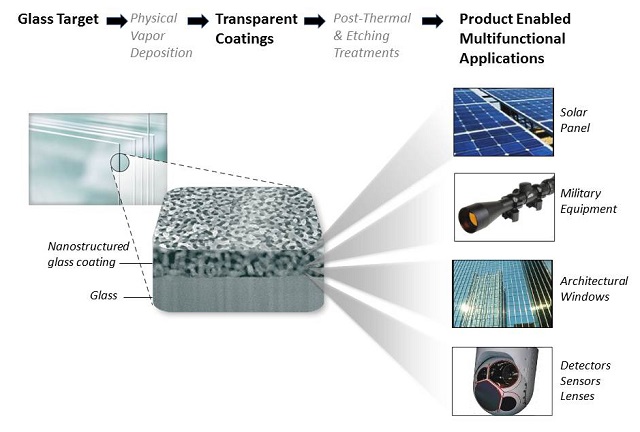 Schematic representation of the coated product and applications.
Schematic representation of the coated product and applications.
Drawing inspiration from a lotus leaf and moth’s eye, a research group at the Oak Ridge National Laboratory (ORNL) of the Department of Energy has developed an antireflective, superhydrophobic glass coating.
The potential applications of this novel water-repelling glass coating include products such as weapon systems, windows, detectors, lenses, solar panels and so on. A mechanically strong nanostructured layer of porous glass film forms the basis of this breakthrough coating. It is possible to customize this coating to be antireflective, fog resistant and superhydrophobic.
The study results have appeared in the Journal of Materials Chemistry C as an article titled “Monolithic Graded-Refractive-Index Glass-based Antireflective Coatings: Broadband/Omnidirectional Light Harvesting and Self-Cleaning Characteristics.”
While lotus leaves repel water and self-clean when it rains, a moth’s eyes are antireflective because of naturally covered tapered nanostructures where the refractive index gradually increases as light travels to the moth’s cornea. Combined, these features provide truly game-changing ability to design coatings for specific properties and performance.
Tolga Aytug, a member of ORNL’s Materials Chemistry Group and the lead author of the paper
A surface needs to have a water droplet contact angle beyond 150° in order to exhibit superhydrophobicity. The contact angle achieved by ORNL’s coating is at the range of 150-165°, thus causing water to bounce off. As a result, dirt and dust are carried away.
The unique combination of superhydrophobicity and the suppression of light reflected off a glass surface is vital to achieve improved performance in a myriad of optical applications, explained Aytug. The base material used is a special type of glass coating, which exhibits high durability. This quality provides it a competitive edge over other technologies, said Aytug.
Aytug went on to describe the process that, “We developed a method that starts with depositing a thin layer of glass material on a glass surface followed by thermal processing and selective material removal by etching.” “This produces a surface consisting of a porous three-dimensional network of high-silica content glass that resembles microscopic coral.”
Industry standard techniques can be used to fabricate this novel coating. Therefore, the coating process can be easily scaled up and applied to several glass platforms cost effectively.
The unique three-dimensionality interconnected nanoporous nature of our coatings significantly suppresses Fresnel light reflections from glass surfaces, providing enhanced transmission over a wide range of wavelengths and angles.
Tolga Aytug
The Fresnel effect can be explained as the amount of light that is reflected off a surface against the amount of light transmitted through the surface.
For instance, the suppression of light reflection in the case of solar panels increases the conversion efficiency and power output of the solar cells by 3-6%. The incorporation of the superhydrophobic self-cleaning ability could considerably minimize expenses associated with solar panel operation and maintenance. Moreover, ultraviolet light can be effectively blocked with this coating.
Sensors, photodetectors, optical instruments, periscopes, goggles, are the other potential applications of ORNL’s coating. Additionally, snow and ice accumulation on optical components and biofouling in marine applications can be prevented, thanks to the superhydrophobic property of the coating. Aytug highlighted that the impact abrasion resistance property further extends the applications of the coating.
“This quality differentiates it from traditional polymeric and powder-based counterparts, which are generally mechanically fragile,” Aytug said. “We have shown that our nanostructure glass coatings exhibit superior mechanical resistance to impact abrasion – like sand storms – and are thermally stable to temperatures approaching 500 degrees Celsius.”
David Christen, Parans Paranthaman, John Simpson, Scott Hunter, Edgar Lara-Curzio, Rosa Trejo, Rajesh Menon, Peng Wang, Tao Liu, Ilia Ivanov, Pooran Joshi, Gerald Jellison, and Andrew Lupini have also contributed to the paper.
The Laboratory Directed Technology Innovation Program supported this research work and the DOE Office of Science Basic Energy Sciences supported the STEM research. A part of the work was carried out at the Center for Nanophase Materials Sciences, which is a DOE Office of Science User Facility. At the University of Utah, photovoltaic device measurements were performed.
References